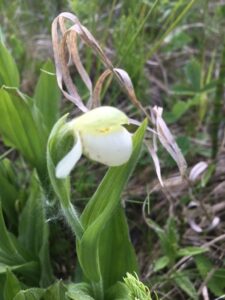Cypripedium candidum

Unveiling the Secrets: Propagating the Elusive Small White Lady’s Slipper (Cypripedium candidum)
The Small White Lady’s Slipper (Cypripedium candidum) is a sight to behold. Its delicate white slipper-shaped bloom, accented with delicate green veins, captivates plant enthusiasts. Sadly, this orchid’s beauty is countered by its increasing rarity in the wild. Habitat loss and unsustainable collecting practices have driven it to be listed as endangered in many areas.
While admiring this delicate flower in its natural habitat is ideal, responsible propagation offers a way to preserve and enjoy the species. Be warned, however – propagating Cypripedium candidum is not for the faint of heart! This delicate orchid requires patience, dedication, and a light touch.
Let’s explore two methods enthusiasts use to propagate this enigmatic beauty:
1. Division:
This method relies on separating mature clumps of Cypripedium candidum. Here’s a breakdown:
- Timing is Key: Divide the plants in early fall when they have entered dormancy. This minimizes stress and maximizes their chance of establishing themselves.
- Gentle Handling: Carefully lift the clump from the ground using a garden fork, ensuring minimal root disturbance.
- Division with Care: Look for natural divisions in the rhizome (the underground stem). Ideally, each division should have a minimum of three healthy shoots.
- Replanting: Immediately replant the divisions in a well-prepared bed that mimics their natural habitat (more on that later).
2. Seed Germination (Advanced):
Propagating Cypripedium candidum from seed is a challenging endeavor, often best left to experienced growers. Orchid seeds are incredibly tiny and lack stored energy reserves. They require a symbiotic relationship with specific fungi to germinate and grow.
Here’s a peek into the process:
- Specialized Conditions: Cypripedium candidum seeds require a sterile, controlled environment with specific nutrients and the presence of the correct mycorrhizal fungi.
- Patience is Paramount: Germination can take months or even years. Once germinated, seedlings are slow-growing and require several years to reach a size capable of flowering.
Creating the Ideal Growing Environment:
Whether you’re propagating through division or seed, replicating the Small White Lady’s Slipper’s native environment is crucial for success:
- Well-Draining Soil: A mix of peat moss, perlite, and sand creates the perfect airy and moisture-retentive environment for the orchid’s delicate roots.
- Partial Shade: Mimic the dappled sunlight this orchid receives in the wild. A spot that receives morning sun and afternoon shade is ideal.
- Consistent Moisture: Keep the soil consistently moist but never waterlogged. Avoid overhead watering, as it can lead to fungal diseases.
Ethical Considerations:
It’s vital to remember that collecting wild Cypripedium candidum is detrimental to the species’ survival. Always obtain plants for propagation from reputable sources that specialize in nursery-propagated orchids.
Propagating the Small White Lady’s Slipper is a challenging yet rewarding endeavor. By understanding the plant’s needs and employing ethical practices, passionate individuals can play a part in ensuring the survival of this captivating orchid for generations to come.